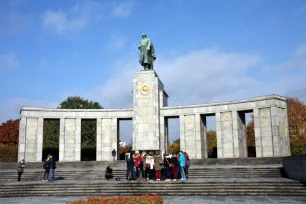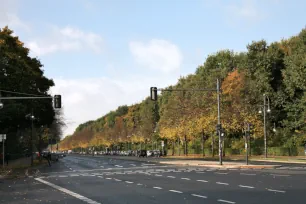The Soviet War Memorial at the Tiergarten is one of several such memorials erected in Berlin by the Soviet Union to honor its war dead. It was erected just a few months after the capture of the city of Berlin in 1945.

The Memorial
The Soviet War Memorial sits on the Straße des 17. Juni (17th of June Street) at the intersection of the former Siegesallee (Victory Avenue), not far from the Brandenburg Gate and the Reichstag. It was located in the British sector of the city, but the building of the memorial was supported by all World War II allied powers.
When the memorial was first built, it sat among the ruins of the Tiergarten park, which had been destroyed by bombs. Until the end of the Cold War, the memorial was guarded by two Soviet soldiers, even though it was located in West Berlin.
The Design of the Memorial


The Soviet War Memorial is a curved colonnade with one central column, atop which sits an 8-meter-tall (26 ft) bronze statue of a Soviet soldier. The statue was designed by the Russian sculptor Lev Kerbel, and shows the soldier with a weapon over his shoulder, which symbolizes the end of the war. The soldier’s arm is slightly raised, pointing towards his fallen comrades.
Underneath the huge bronze soldier are a gold crest and a Cyrillic inscription which reads “Eternal glory to the heroes who fell in battle with the German fascist occupiers for the freedom and independence of the Soviet Union”.
The gardens around the memorial are beautifully landscaped, but on each side of the colonnade sits a few items not quite so beautiful – two T-34 tanks, allegedly the first two that arrived in the city.
The memorial is currently maintained by the city of Berlin, but many modern day Berliners are not happy that this memorial remains standing and have given it less-than-complimentary nicknames. Nevertheless, the Soviet War Memorial at the Tiergarten is still host to a number of annual commemorative activities, including a VE Day celebration on May 8th. Together with the similar Soviet War Memorial in Treptow, it is also a popular tourist attraction for Russian visitors to the city.
Straße des 17. Juni

The memorial was built along the Charlottenburger Chaussee, now the Straße des 17. Juni. The street’s current name commemorates a 1953 revolt against the East German government. On the 17th of June 1953, Soviet tanks were used to violently suppress a workers’ revolt. The Charlottenburger Chaussee, a wide boulevard that cuts through the Tiergarten in what was then West Berlin, was renamed to remind people of the Soviets’ brutal regime against its own citizens.
- Next: Altes Museum
- More Sights & Attractions in Berlin

